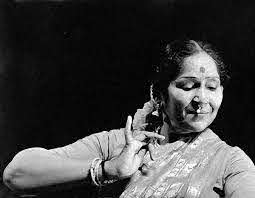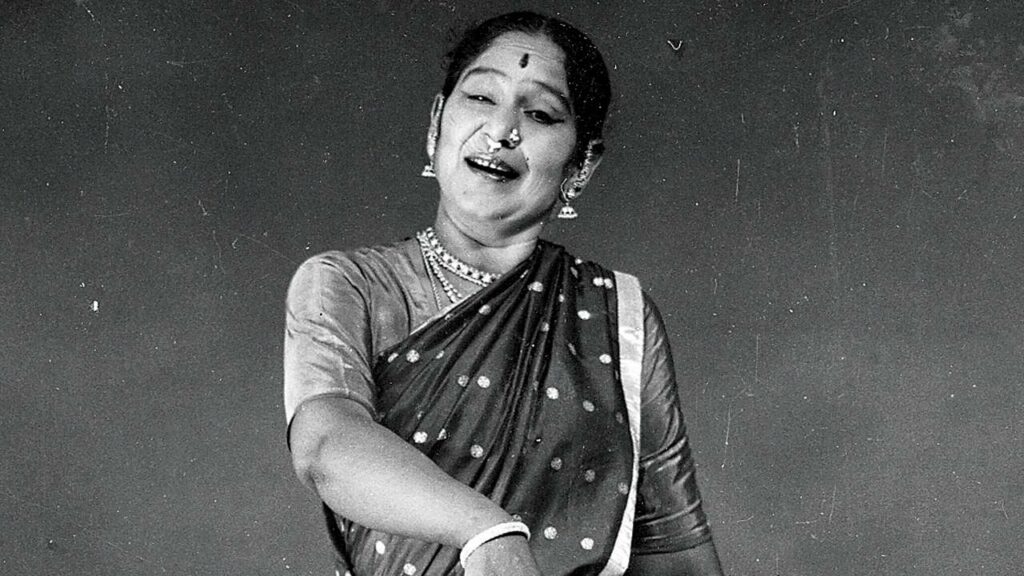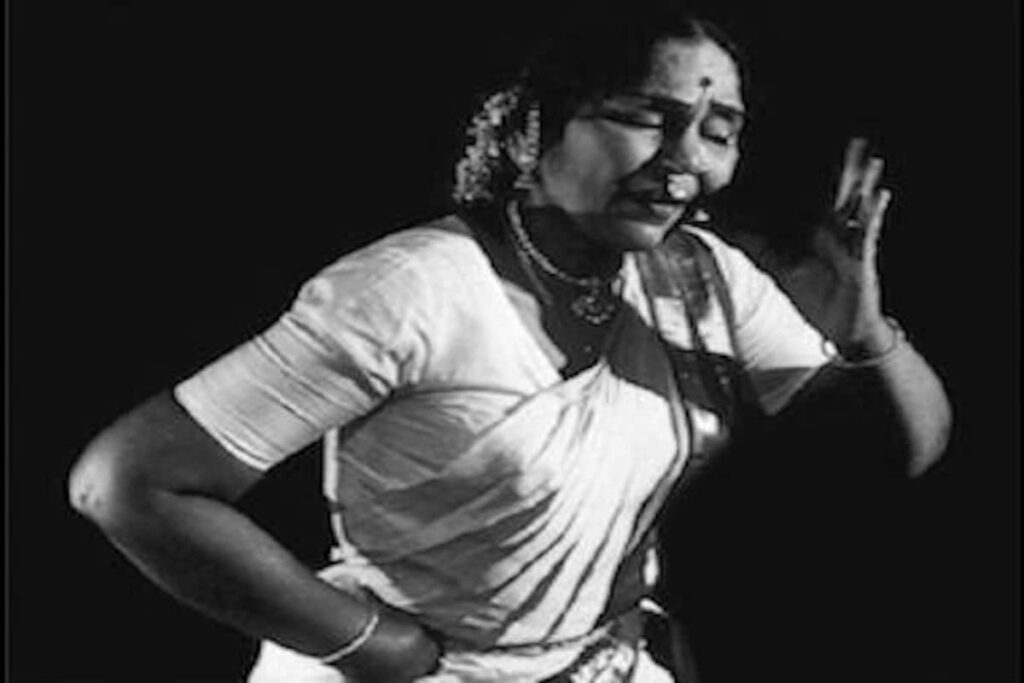Distinguished Guest Column
By Savita Narasimhan




“From the day I first heard this music, I have been unabashedly in love with it.” Says Savita Narasimhan, a Carnatic vocalist, teacher and painter. She is also the Director of the Chennai-based Museum of Performing Arts MOPA. This article is from a series she wrote as she curated MOPA’s first exhibition on Balasaraswati titled ‘Credo of a Dancer’. In the Carnatic world, most of us in my generation or the next have heard and been enamoured of the music of T Brinda and T Mukta and through them, their grandmother, the great Veena Dhanammal, whose music we may not have heard much, but whose tales form part of the Carnatic lore that is handed to every eager student. From the day I first heard this music, I have been unabashedly in love with it. It was March 2019 and I had begun working on an exhibition on another member of the Dhanammal family, the redoubtable Balasaraswati, to mark her birth centenary. I had the privilege of hearing her brother T Viswanathan live just once. This was in the late 90s and his demise left me yearning for more. Curating an exhibition on Bala brought me back into the warm embrace of their music. Her grandson Aniruddha shared several recordings of her music that day and I recall the first time I heard ‘mosa jesene’ in Sindubhairavi. This recording had Bala and her brother exchanging phrases even as she danced (her voice coming from farther away on the stage). It had, besides an obvious Hindustani influence, a richness, a uniqueness, a depth of feeling that ran in my head for months after I first heard it. It left me hungry for more of her music. The next few months saw me hunting for all possible recordings. I realised that there were striking differences between Bala and her cousins Brinda and Mukta. That was explained by Viswa speaking about how each one developed his or her own styles even within the family, while being bound by the aesthetic and musical values that could be traced back to their grandmother. In and down each generation of the family, there had been a lateral transfusion of music from impeccable sources that were handed down as a precious and unbroken heritage. To quote Bala in her speech at the Music Academy, “my great grandmother Sundarammal was a musician as was my grandmother Dhanammal and my mother Jayammal.” The compositions of Shyama Shastri and Subbaraya Shastri were inherited heirlooms, with Sundarammal having learnt directly from Annaswami Shastri. Family lore says that Annaswami Shastri would insist that Sundarammal sing his father’s Todi kriti ‘nannu brochutaku tamasamela’ everyday. This composition became the personal property of Sundarammal who taught it to Dhanammal, who in turn passed it on to Balasaraswati, but never to any other family member or outsider. Anayya’s compositions like ‘charanu charanu’ in Chenjuruti and ‘mahima teliya tarama’ in Shankarabharanam (known better as a pallavi) were family property. The compositions of Muthuswamy Dikshitar in the family also had a direct link to the composer himself. Dhanammal’s guru Panchu Iyer was the disciple of Tambiappa Pillai, a direct disciple of Dikshitar. It was to cure Tambiappa’s illness that Dikshitar composed the Navagraha kriti-s. Veena pustaka dharini in Vegavahini was similarly an exclusive family property. Dhanammal learnt many compositions of Tyagaraja’s direct disciple Veena Kuppier and his son Tiruvottriyur Tyagier from the latter, a great friend and admirer of Dhanammal, many years his junior. She was also perhaps the first musician who rendered Ettayapuram Kumara Ettendra’s compositions as outlined in Subbarama Dikshitar’s Sangita Sampradaya Pradarshini. Prominent composers like Patnam Subramania Iyer, Tiruvottriyur Tyagaier and Dharmapuri Subbarayar composed in her presence and enriched their compositions further by her musical touches. The famous javali ‘smara sundaranguni’ in Paras composed by Dharmapuri Subbarayar was in praise of Dhanammal. Jayammal taught Bala the close relationship between abhinaya and raga, saying “your head, your whole body, must move with the gamaka, the sangati, not just with tala.” Bala’s guru Kandappa Pillai’s rhythmic compositions were guided largely by musical principles and the dance simply had to follow. In the family tradition, raga-s were given life not only through ornamentation (gamaka-s) but also with an intuitive and effective use of voice, intonation and modulation to arrive at the optimal sound and mood. With such a background and training, it is not surprising that almost all of Bala’s artistic decisions were informed by her music. The text may have guided the meaning but it was the musical phrase that shaped the gesture and expression, thereby creating the emotion. Such was her ability to understand the inherent mood of the raga that the music became the catalyst for mime, providing endless options. In Bharatanatyam, the padam is considered the compositional form that gives a dancer maximum scope to express her artistic skills. It is also extremely difficult to sing a padam well, given its super slow pace and nuanced structure and its demands on the musician’s vocal, technical and aesthetic abilities. Bala believed that the padam must be explored continuously because of the infinite possibilities in the poetry and music, the unlimited interpretative possibilities. She developed an instinctive dependence upon the musical gesture as a guide to abhinaya. John Higgins summed this point up succinctly in his presentation at the Music Academy: “To watch Bala sing is to begin to understand a padam…her body leans into each musical phrase as if to coerce it; each syllable of sahitya is allowed to find its level, its own unique sound value. Thus in a dance performance, Balasaraswati breathes with music and the music breathes life into her gestures.” There is a delightful video recording of her brother Viswanathan talking about how she would continuously think musically, taking apart the smallest detail of the song in order to examine it freshly and present it in new ways. A phrase – explored, analyzed, treated with her voice, transformed from a phrase to a ‘opening up’ of myriad forms of expression. He tries to demonstrate her mime for the word ‘vaari’ (combing one’s tresses) by singing the word in various ways in Saveri. We can find a short segment of this by Bala herself in Satyajit Ray’s movie ‘Bala’. Hearing Bala sing, one understands how tradition is best preserved by an exceptional artiste, not as an antiquated, inflexible heirloom but as an intelligent synthesis of live influences and inherited values. Bala had grown up with the music of Abdul Karim Khan, Roshanara Begum and Gauhar Jan. She developed close bonds and spent considerable time with Amir Khan and Siddeshwari Devi, singing for hours together, trading raga-s and patterns. Her fondness for Hindustani music reflected in the way she dwelt on notes like the Shuddha Rishabham, Prati Madhyamam and Shuddha Daivatam and in the way she handled even core Carnatic raga-s like Shankarabharam in the verse pannen unakkana pujai or Poorvikalyani in the Navarasa Shlokam. Such was the musicianship of Bala that she drew the best musicians into her orchestra. Other than her guru Kandappa Pillai and mother Jayammal who sang for her, she had such stellar musicians as Kanchipuram Ellappa Pillai, Gnanasundaram (or Gnani as he was called), Narasimhulu, Balaraman, Radhakrishna Naidu and Kuppuswami Mudaliar. Her concerts drew top musicians who came to savour the rich and complex music she and her orchestra offered. In the midst of her dance, she would launch into song with a force of her own. This left the singer not miffed, but nodding in admiration! The unique feature of Bala and her musicians was that all members of her ensemble performed with a profound understanding of one another, their shared relationship to Bala’s dance and deep respect for her musical vision and abilities. Another very interesting feature I noticed is the jaw (and back) breaking pace of the jatiswaram-s(Vasanta and Poorvikalyani) and even varnam-s like Mohamana (Bhairavi) and Danike (Todi). The sense of space and timing even at such a pace could have been possible only with complete mastery of both idioms. The slow renditions one hears in today’s recitals are obviously a recent phenomenon. In the usual but deplorable neglect of archiving our artistes at their peak, not much was done to record Bala or her family’s art for posterity and much has been lost as a result. Family records reveal that she had in her repertoire nearly a 100 padam-s, more than 50 javali-s and any number of alarippu-s, jatiswaram-s and varnam-s. What a loss indeed! Her music lives on in old memories and a few recordings, enough for us to understand how she remains the only dancer ever to have received the Madras Music Academy’s Sangita Kalanidhi, the veritable ‘Nobel’ prize of the Carnatic world, and the ‘Isai Perarignar’ from the Tamil Isai Sangam, such being her musical prowess. As I hear her rendition of ‘mukti alikkum’, the serene antara gandharam of Chenjuruti fills the air and generates a sense of peace and stillness. I recall the moving incident recounted by Sakuntala Narasimhan: ‘…and how she sang! It melted your insides and left you feeling vaguely chastened…along with stalwarts like Semmangudi Srinivasa Iyer and M. S. Subbulakshmi, she broadcast her inaugural program from All India Radio, Madras, in June 1938. I remember that broadcast too, for I was there fortuitously, in the studios, when the recording was made…the man in the control room gesticulated, asking her to round off her song at ‘twenty eight and a half minutes’, and she gave him a half-amused, half-quizzical look… ‘How can you time a song like that…I shall stop the song when it is finished…” For the like of her, time was but a niggling irrelevance, of no import in the perspective of an art that had come down through aeons of heritage.” Savita Narasimhan is a Carnatic vocalist, teacher and painter. She is also the Director of the Chennai-based Museum of Performing Arts MOPA. This article is one of a series she wrote as she curated MOPA’s first exhibition on Balasaraswati titled ‘Credo of a Dancer’.










